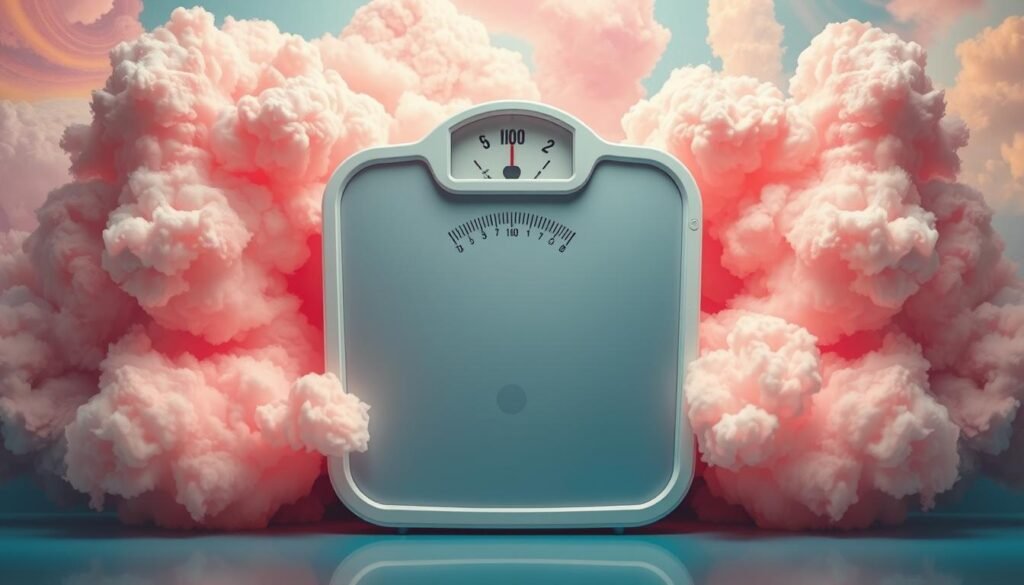Over 1 in 100 people taking mirtazapine might notice side effects. These include feeling more hungry, putting on weight, and getting a dry mouth. It’s all about knowing what could happen using side effects of Mirtazapine for Anxiety. Mirtazapine is also called Remeron. It’s used to help folks deal with anxiety and depression. But, some folks might have no issues, while others may need to watch out closely and talk with their doctors.
It’s key to know about the mirtazapine side effects when using it for anxiety. It helps to think about your health history, what meds you’re on, and how you live day by day. This can change how you feel these side effects. To get more info on mirtazapine and tips on managing side effects, here’s a good read: Mirtazapine for Anxiety.
Key Takeaways
- Over 1 in 100 individuals may experience side effects from mirtazapine.
- Common side effects include dry mouth, increased appetite, and drowsiness.
- Serious side effects occur in less than 1 in 10,000 people but require immediate attention.
- Monitoring side effects is essential for effective anxiety treatment with mirtazapine.
- Health history and current medications can influence side effects experienced.
Introduction to Mirtazapine
Mirtazapine is a well-known mirtazapine antidepressant. It is part of the noradrenergic and specific serotonergic antidepressants (NaSSA) group. It mainly focuses on treating major depressive disorder. It also helps with anxiety disorders. This is because it adjusts the levels of norepinephrine and serotonin. These changes help improve mood and reduce anxiety.
The benefits of mirtazapine go beyond depression and anxiety treatment. Studies show it gives better results than some other meds. For instance, 62% of patients with melancholic depression improved on mirtazapine, more than on venlafaxine. People often feel better faster with it, especially when they have both anxiety and depression.
It’s good to know how mirtazapine works to use it better. Mixing it with other meds may even improve results. This is important because many American adults have anxiety disorders. For more about mixing mirtazapine, you can check here.
What is Mirtazapine?
Mirtazapine is a type of antidepressant often used when other treatments don’t work. It’s really good at improving feelings of well-being for people with anxiety or depression. The medication increases serotonin and norepinephrine in the brain, which are important for mood regulation.
It helps with issues like insomnia and poor appetite, which are common in anxiety sufferers. Learning about how mirtazapine works shows us its calming effects. These include better sleep and more eating. That’s why many choose mirtazapine if they have these problems.
Usually, mirtazapine starts to work within a few weeks. So, it’s important to keep taking it as prescribed. Knowing about side effects such as sleepiness and wanting to eat more can assist in managing them. For more on similar medications, check this resource.
Understanding the Side Effects of Mirtazapine for Anxiety
Mirtazapine can cause different side effects, from mild to severe. Knowing these effects is vital for people looking at this medication for anxiety relief.
Common Side Effects
Common side effects happen to more than 1 in 100 people taking mirtazapine. These effects include:
- Dry mouth
- Increased appetite
- Weight gain
- Drowsiness
- Headaches
- Nausea
- Vomiting
- Diarrhea
- Constipation
Common side effects might decrease as your body gets used to the medication. It is important to keep talking to your doctor if the symptoms don’t go away or get worse.
Rare but Serious Side Effects
Rare, serious side effects from mirtazapine happen in less than 1 in 10,000 users. Some of the serious health risks are:
- Pancreatitis – Severe abdominal pain could be a sign of this.
- Low sodium levels – Watch out for confusion and weakness.
- Liver damage – Yellow skin or eyes can be a warning.
- Agranulocytosis – This can cause fever and flu-like signs.
- Severe allergic reactions – You might have trouble breathing or get skin rashes.
- Suicidal thoughts or actions – This is a concern especially for youth and teenagers.
- Serotonin syndrome – Severe symptoms include sweating and seizures.
Knowing the severe side effects of mirtazapine is key for safe use. Always report any severe symptoms to a doctor right away.
Mirtazapine and Weight Gain
Mirtazapine can lead to mirtazapine weight gain, which might be tough for some people. Studies show an average increase of about 8 lbs in just six weeks of use. This is due to the medication’s effect on appetite, even at doses as low as 7.5 mg.
How much weight a person gains on mirtazapine can vary. On average, patients may see an increase of 3.3 to 9.9 lbs. This depends on how much and how long they take the medicine, and their lifestyle. It’s important to note that it can also change where fat is stored, mainly around the belly, which could lead to obesity.
Mirtazapine can mess with how leptin, a key hunger hormone, works in the body. This can make you less sensitive to leptin, leading to more managing weight gain on mirtazapine. Studies found people taking mirtazapine gained more weight than those who didn’t take it.
During the first 8 to 12 weeks on mirtazapine, the average weight gain is about 3 lbs. This increase is more noticeable earlier on. However, many people start to gain less weight after they stop taking the medicine. This shows that with careful observation and lifestyle changes, managing this weight gain is possible.

Talking often with doctors helps in finding ways to handle weight gain while using mirtazapine. For those curious about the drug’s metabolic effects, ongoing research offers valuable information. An interesting study is available in the Journal of Clinical Psychiatry.
| Weight Gain Category | Weight Gain (lbs) | Comment |
|---|---|---|
| Initial Phase (8-12 weeks) | 3 lbs | Average gain during the first weeks. |
| 6-Week Treatment | 8 lbs | Average observed gain in study. |
| 40-Week Continuation Therapy | 3.1 lbs | Average gain during extended treatment. |
| Overall Average Gain | 10 lbs | For a person weighing 150 lbs. |
Mirtazapine Drowsiness and Its Impact
Many people starting on mirtazapine feel very sleepy. This drowsiness can deeply affect someone’s effects of mirtazapine on daily life, making activities needing sharp focus harder. Tasks like driving or using machines can become risky.
It’s crucial to check how mirtazapine makes you feel before doing things that need full attention. Everyone should pay close attention to how they react when they first use the medicine. This way, they can figure out a safe daily routine. Most doctors say taking it at night lessens the chance of feeling tired in the morning.
A study found that almost half its participants felt strong sleepiness. Those dealing with this side effect might have to change their daily plans. This ensures they stay safe and keep up with their tasks.
Mirtazapine Interactions: What You Need to Know
Mirtazapine interacts with different medications and substances. Knowing these interactions is key for users. It prevents serious side effects and makes treatment more effective.
Drug Interactions
Some medications, like monoamine oxidase inhibitors (MAOIs), benzodiazepines, and those affecting the CYP3A4 enzyme, should be avoided. Mixing mirtazapine with them can increase serotonin syndrome risk. This condition comes with rapid heartbeat, agitation, and confusion.
Mixing mirtazapine with drugs that impact the QT interval is risky. It could cause dangerous heart rhythms.
Food and Alcohol Interactions
Alcohol and mirtazapine together increase sleepiness and can slow your thinking. So, staying away from alcohol during treatment is advised. Eating certain foods may also affect how mirtazapine works and its side effects. Following your healthcare provider’s food advice ensures a safer treatment.

| Interaction Type | Examples | Effects |
|---|---|---|
| Medications | MAOIs, benzodiazepines, certain pain medications | Increased risk of serotonin syndrome |
| Alcohol | Alcoholic beverages | Enhanced sedation, impaired cognition |
| Foods | Grapefruit, specific dietary supplements | Alteration of mirtazapine metabolism |
Mirtazapine Dosage for Anxiety Treatment
Using mirtazapine for anxiety means starting with the right dose. Usually, doctors recommend 15 to 30 mg per day, taken at bedtime. This dose is kept for two to four weeks. It lets the medication build up and starts to work on anxiety.
Since everyone reacts differently to mirtazapine, keeping in touch with your doctor is crucial. They will watch your progress and adjust the dose if needed. If necessary, the dose can go up to 45 mg per day to get better results.
Mirtazapine comes in dispersible tablets of 15 mg, 30 mg, and 45 mg. The right dose depends on various factors, like a patient’s health history and how well they tolerate the medication.
Finding the correct dose of mirtazapine for anxiety is a team effort. It involves the patient and their healthcare provider working together. By regularly checking on the medication’s effects and any side effects, they can make sure the treatment is as effective and safe as possible.
Monitoring Mirtazapine Side Effects Over Time
Checking side effects while using mirtazapine is key for people treating depression or anxiety. Regular check-ups will help see how you respond to the medicine. It allows for quick dose changes if needed. Some side effects could stick around and might need extra care.
Part of monitoring mirtazapine includes getting blood tests regularly. These tests can spot any major health shifts. They look for liver function, sodium levels, and overall health changes. This is vital if you’re gaining weight or eating more. It’s especially important for older folks who break down the medicine slower. This can up their risk of side effects.
Talking openly with doctors makes a supportive space. This helps people feel okay to report bad effects right away. Issues like dizziness, nausea, or feeling tired at first may get better with time. But, you should watch out for new side effects or mood shifts. Talk to your doctor fast if these happen.
Some side effects can be severe, like serotonin syndrome or low sodium in the blood. So, patients and doctors need to watch closely. Knowing what symptoms to look out for and when to meet up next helps keep treatment safe.
| Side Effects | Commonality |
|---|---|
| Sleepiness | Common |
| Dizziness | Common |
| Weight Gain | Common |
| Serotonin Syndrome | Rare but Serious |
| Low Blood Sodium Levels | Rare but Serious |
Talking with healthcare experts is crucial for people thinking about mirtazapine’s long-term side effects. Open conversations help better manage and understand treatment plans. With good info, folks can better manage their health.

Long-term Effects of Mirtazapine Use
If you’re taking mirtazapine, you should consider its long-term effects. It’s effective for anxiety and depression. But, using it a lot can lead to health issues. One major worry is metabolic changes. These changes may make diabetes and heart disease more likely.
Even though we don’t know all the long-term effects yet, researchers are working hard to find out. They want to understand what happens with long use of mirtazapine.
Some people might get used to mirtazapine’s side effects. But, stopping it suddenly can cause issues like dizziness, nausea, and more anxiety. It’s important to follow advice from doctors on how to slowly stop the medication. This helps reduce withdrawal symptoms.
Mirtazapine comes with several side effects. A common one is gaining weight, maybe because of metabolic changes or more cravings for carbs. You might also feel sleepy, have a dry mouth, or have trouble sleeping. All these can make daily life harder.
Understanding mirtazapine’s effects over time is crucial. Talking with healthcare providers helps keep track of how it’s working and its side effects. This conversation is key for planning long-term treatment and getting better outcomes for patients.
| Effect | Impact | Notes |
|---|---|---|
| Metabolic Changes | Increased risk of diabetes and cardiovascular disease | Long-term use may contribute to metabolic alterations |
| Withdrawal Symptoms | Dizziness, nausea, insomnia | Symptoms may manifest after abrupt discontinuation |
| Weight Gain | Common side effect | Related to metabolic changes and cravings |
| Drowsiness and Sleep Disorders | Affects daily activities and quality of life | Mirtazapine impacts different sleep phases |
Conclusion
It’s crucial to know about mirtazapine treatment overview if you’re considering it for anxiety. Mirtazapine is helpful in treating major depressive disorder and is different from other antidepressants. But, it’s also key to understand the possible side effects.
Many folks manage the side effects well. However, a side effects of mirtazapine summary shows why knowing both common and rare reactions matters.
Talking regularly with healthcare providers helps guide your treatment. These chats make sure benefits are worth the risks, especially for conditions like panic disorder or PTSD. Watching any side effects and knowing how mirtazapine works with other medicines is crucial.
Research, including on COVID-19, continues to highlight mirtazapine’s role. Staying informed helps you look after your mental health. This way, you can use mirtazapine safely and deal with other concerns.